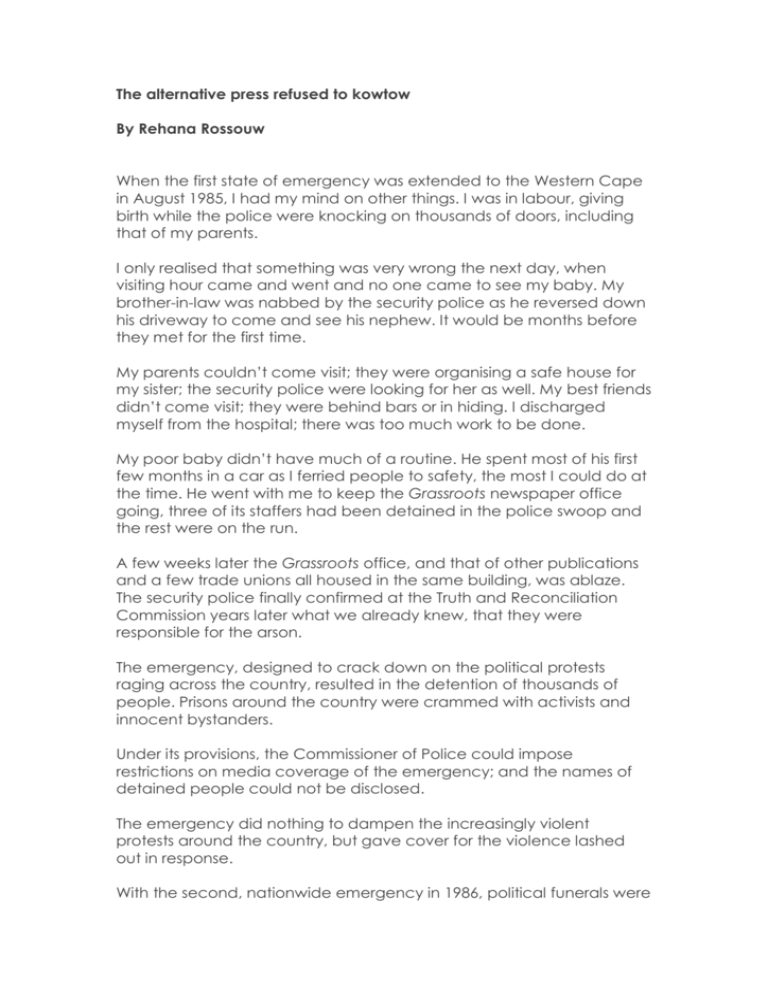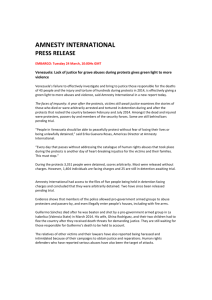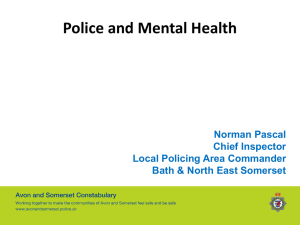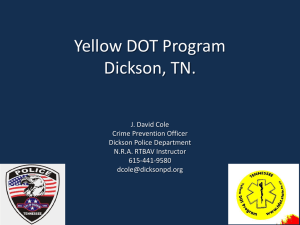Rehana Rossouw`s speech - Nelson Mandela Foundation
advertisement

The alternative press refused to kowtow By Rehana Rossouw When the first state of emergency was extended to the Western Cape in August 1985, I had my mind on other things. I was in labour, giving birth while the police were knocking on thousands of doors, including that of my parents. I only realised that something was very wrong the next day, when visiting hour came and went and no one came to see my baby. My brother-in-law was nabbed by the security police as he reversed down his driveway to come and see his nephew. It would be months before they met for the first time. My parents couldn’t come visit; they were organising a safe house for my sister; the security police were looking for her as well. My best friends didn’t come visit; they were behind bars or in hiding. I discharged myself from the hospital; there was too much work to be done. My poor baby didn’t have much of a routine. He spent most of his first few months in a car as I ferried people to safety, the most I could do at the time. He went with me to keep the Grassroots newspaper office going, three of its staffers had been detained in the police swoop and the rest were on the run. A few weeks later the Grassroots office, and that of other publications and a few trade unions all housed in the same building, was ablaze. The security police finally confirmed at the Truth and Reconciliation Commission years later what we already knew, that they were responsible for the arson. The emergency, designed to crack down on the political protests raging across the country, resulted in the detention of thousands of people. Prisons around the country were crammed with activists and innocent bystanders. Under its provisions, the Commissioner of Police could impose restrictions on media coverage of the emergency; and the names of detained people could not be disclosed. The emergency did nothing to dampen the increasingly violent protests around the country, but gave cover for the violence lashed out in response. With the second, nationwide emergency in 1986, political funerals were restricted, curfews were imposed, certain indoor gatherings were banned and news crews with television cameras were banned from filming in areas where there was political action. This prevented some news coverage of the unceasing wave of protests that draconian measures could not contain. An estimated 26,000 people were detained between June 1986 and June 1987. Journalists across the country were swept up in waves of detentions, many held for months, Zwelakhe Sisulu for two years. When they came for me, my baby went with me – as usual – and added some life to my solitary confinement. When enterprising journalists found loopholes in the sloppily drafted restrictions, the state gave itself the power to suspend newspapers if they disapproved of its contents. Grassroots and South, and many other publications across the country, were suspended several times and for months at a time. Finally, when this also failed to stop the truth from being published, the state in turned its attention to individual journalists – granting Home Affairs Minister Stoffel Botha the power to require journalists to register with the government, and to withhold registration from those he felt did not conform with apartheid's view of acceptable journalism. Sound familiar? They did not succeed then, and I hope they do not now. Despite all these restrictions, the media and especially what was known as the alternative press – Grassroots, South, Saamstaan, New Nation, New African, the Weekly Mail, Vrye Weekblad and many more – refused to kowtow. Journalists launched the Save the Press Campaign to lobby internally and externally against the restrictions. So what about the photographers, you may ask? The authorities eventually made it an offence to be present at an incident of 'unrest' or security force action. For many brave reporters and photographers, that was exactly where they wanted to be. We had never before witnessed such scenes as were unfolding on our streets: the black smoke of burning tyre barricades dotting the landscape, the brave priests, arms locked in solidarity with imams and rabbis, leading thousands of people down streets bristling with armed soldiers and police, the angry youth taking on Casspirs with stones and petrol bombs, the violent response, the mourning bodies draped over the dead. This is what it was like, for me at least, working with those brave photographers, some of whom never recovered from the scenes of horror plastered onto their retinas as they aimed their cameras at the protests. The guns would crack; the crowd would scatter and the photographer would race in the direction everyone else was fleeing from. I don’t know if it was only me, but often the photographer I was working with would drop his or her bag and expect me to take control when the chaos erupted. I would also bravely race towards the mayhem, lugging a heavy bag filled with cameras, lenses and the photographers’ lunch. And I’d have to try to take notes while lugging my burden and stuffing film canisters into my bra to keep safe from police searches. Some of those photographers were activists, committed to the cause and willing to sacrifice for democracy in their lifetimes. All were professionals, but some were only that. I’ve worked with photographers who were army reservists and took guns to protests – another heavy thing to lug in that bag – but their photographs of that glorious and tragic time in our history are equally striking. And they had to fight equally hard with conservative editors to get their work published. Which brings me to my final point. Activist or not, people working in the alternative media are entitled to recognition as professionals. They may have been a bit deeper in the trenches, a bit more heartbroken by state violence unleashed on people clamouring for freedom, and paid a lot less when they worked for the alternative press, but they went out onto the streets, day after bloody day, recording the truth that the state’s lies could no longer conceal. So today, when people who may not have joined the struggle to be poor, reproduce their work without payment, without recognition, they have every right to protest. And I join them unreservedly in their struggle. I published a book this year; I know just how paltry royalties are. My nephew told me recently that his university, scampering to find black reality to include in their curriculum, was teaching art history students a module on photographers in the struggle. He said to me, that Zubeida Vallie, her work is amazing! I know her, I said, I worked with her in the eighties. Wow, he said. Wow indeed. I salute the Nelson Mandela Foundation for also giving these photographers the recognition they deserve. Thank you. Rehana Rossouw is a South African journalist and former anti-apartheid activist who was detained during the State of Emergency. Roussouw who this year published her first novel What will people say? (Jacana) gave the keynote speech at the opening of the exhibition Between States of Emergency at the Nelson Mandela Foundation. The exhibition can be viewed by appointment at 107 Central Street, Houghton, Johannesburg. Contact nmf@nelsonmandela.org








